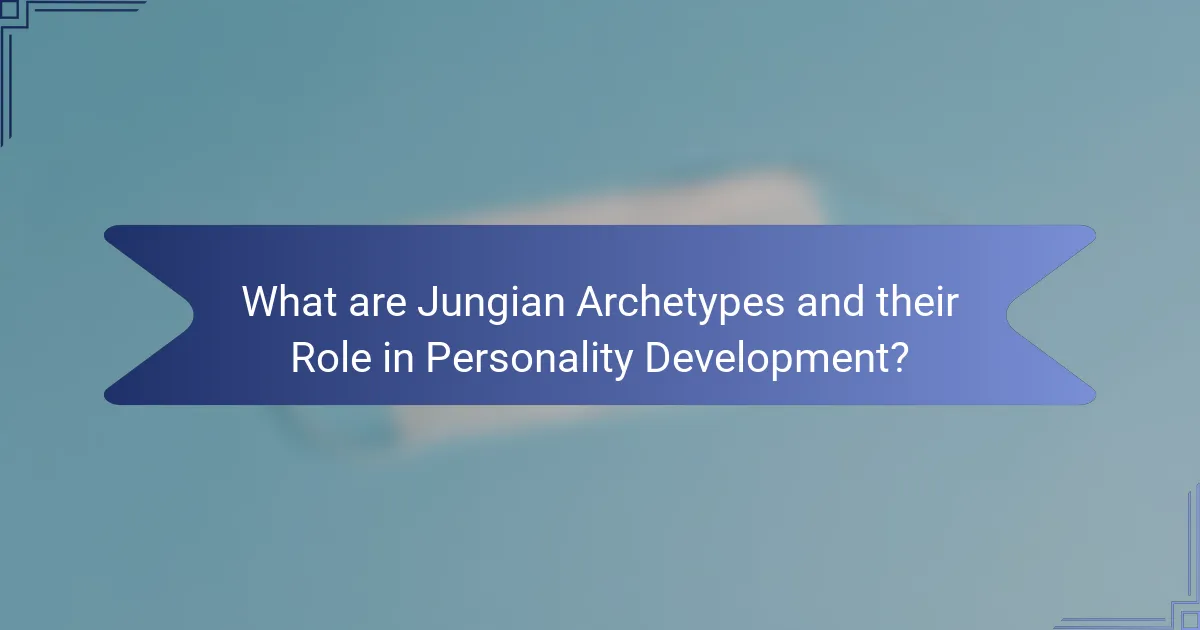Understanding Jungian archetypes can enhance self-awareness and personal growth. These universal symbols influence personality development and behaviours. Key archetypes like the Hero, Mentor, and Shadow reveal insights into our inner selves. Recognising these patterns fosters emotional resilience and improves interpersonal relationships.

What are Jungian Archetypes and their Role in Personality Development?
Jungian archetypes are universal symbols that influence personality development. They shape behaviours, motivations, and personal narratives. Key archetypes include the Hero, the Mentor, and the Shadow, each representing different aspects of the human experience. These archetypes help individuals understand their inner selves and foster personal growth by recognising patterns in their thoughts and actions. Engaging with these archetypes can lead to greater self-awareness and emotional resilience.
How did Carl Jung conceptualise archetypes?
Carl Jung conceptualised archetypes as universal symbols and themes within the collective unconscious that shape human behaviour and personality. These archetypes serve as templates for understanding individual experiences and personal development. Jung identified several key archetypes, including the Hero, the Shadow, and the Anima/Animus, each representing distinct aspects of the human psyche. By recognising and integrating these archetypes, individuals can achieve greater self-awareness and personal growth. Jung’s approach emphasises the importance of these archetypes in navigating life’s challenges and understanding one’s inner self.
What are the core archetypes defined by Jung?
Jung identified twelve core archetypes that represent universal patterns of human behaviour. These archetypes include the Innocent, the Orphan, the Hero, the Caregiver, the Explorer, the Rebel, the Lover, the Creator, the Jester, the Sage, the Magician, and the Ruler. Each archetype embodies distinct attributes that influence personality and personal development, guiding individuals in their life journeys. For example, the Hero represents courage and determination, while the Caregiver emphasises compassion and support. Understanding these archetypes can enhance self-awareness and foster personal growth.
What characteristics define the Hero archetype?
The Hero archetype is characterised by bravery, resilience, and a commitment to a cause. Heroes often embark on quests, overcoming obstacles to achieve personal growth and inspire others. Their unique attribute is the ability to transform adversity into strength, embodying the journey from ordinary to extraordinary. This archetype plays a crucial role in personal development by motivating individuals to confront challenges and strive for greatness.
How does the Shadow archetype influence behaviour?
The Shadow archetype influences behaviour by revealing repressed aspects of the self. It drives individuals to confront their fears and insecurities, fostering personal growth. This confrontation can lead to increased self-awareness and authenticity. Embracing the Shadow encourages integration of all personality facets, enhancing emotional resilience and interpersonal relationships.
What traits are associated with the Anima/Animus archetype?
The Anima/Animus archetype embodies traits of inner femininity and masculinity, influencing personal development. Key traits include emotional depth, intuition, creativity, and balance. The Anima often represents nurturing qualities, while the Animus embodies rationality and assertiveness. This duality fosters psychological integration, enhancing self-awareness and interpersonal relationships. Understanding these traits can lead to personal growth and a more harmonious existence.
What is the significance of archetypes in personal growth?
Jungian archetypes play a crucial role in personal growth by providing a framework for understanding oneself. They help individuals identify patterns in behaviour, motivations, and emotional responses. By recognising these archetypes, one can gain insights into personal strengths and weaknesses, fostering self-awareness and facilitating transformative change. This understanding promotes deeper connections with others, enhancing interpersonal relationships and emotional intelligence. Ultimately, engaging with archetypes empowers individuals to navigate their life journey with greater clarity and purpose.

What are the universal attributes of Jungian Archetypes?
Jungian archetypes share universal attributes that shape personality and personal development. These include the collective unconscious, symbolic representation, and recurring patterns in human behaviour. The archetypes serve as foundational elements that guide individual experiences and interactions. Their unique attribute is the capacity to resonate across cultures, illustrating fundamental human experiences and emotions.
How do archetypes manifest in everyday life?
Jungian archetypes manifest in everyday life through behaviours, roles, and patterns that influence our interactions. For instance, the Hero archetype appears in individuals who take on challenges and inspire others. The Caregiver archetype is evident in those who nurture and support, highlighting the importance of empathy. These archetypes shape our identities and relationships, guiding personal development and self-awareness. Recognising these patterns can enhance emotional intelligence and interpersonal dynamics.
What psychological functions do archetypes serve?
Jungian archetypes serve essential psychological functions by shaping personality and guiding personal development. They act as universal symbols that influence behaviour, thoughts, and emotions. Archetypes help individuals understand their roles within society and promote self-awareness. For example, the Hero archetype encourages resilience and courage, while the Caregiver fosters empathy and nurturing. By recognising these patterns, individuals can navigate their personal journeys more effectively.

What unique attributes differentiate individual archetypes?
Each Jungian archetype possesses unique attributes that define their personality traits and roles. For instance, the Hero archetype is characterised by courage and determination, while the Caregiver embodies compassion and selflessness. These unique attributes differentiate how individuals express their archetype in personal development. The Ruler archetype, with its authority and leadership qualities, contrasts sharply with the Rebel, who values independence and challenges the status quo. Understanding these distinctions aids in recognising one’s own archetypal influences and growth potential.
How do cultural contexts shape archetype interpretations?
Cultural contexts significantly influence how archetypes are interpreted across different societies. These interpretations shape personality traits and personal development pathways. For instance, the Hero archetype may embody bravery in one culture, while in another, it might represent wisdom. Additionally, cultural narratives and myths reinforce specific archetypes, leading to unique expressions of common human experiences. Understanding these variations enhances personal growth by allowing individuals to navigate their identities within their cultural frameworks.
What are the distinctive traits of the Caregiver archetype?
The Caregiver archetype is characterised by empathy, compassion, and a nurturing disposition. This archetype often prioritises the well-being of others, demonstrating selflessness and a strong desire to help. A unique trait of the Caregiver is their ability to create a safe environment, fostering trust and emotional support. Rarely, they may struggle with overextending themselves, leading to burnout. Overall, the Caregiver embodies the essence of unconditional love and service, making them essential in personal development and community building.

What rare attributes are found in specific archetypes?
Rare attributes in specific Jungian archetypes include unique traits that enhance personal development. For instance, the Hero archetype often embodies resilience, while the Sage showcases wisdom. The Rebel may present innovative thinking, and the Caregiver often highlights empathy. Each archetype’s rare attributes contribute to distinct personality expressions and personal growth paths. Understanding these nuances allows individuals to leverage their archetypal strengths effectively.
What are the less common manifestations of the Trickster archetype?
The less common manifestations of the Trickster archetype include the Rebel, the Jester, and the Saboteur. These variations exhibit unique traits that challenge societal norms and provoke thought. The Rebel often instigates change through disruption, while the Jester uses humour to reveal truths. The Saboteur operates subtly, undermining authority in unexpected ways. Understanding these nuances enhances personal development by recognising different aspects of the Trickster within oneself.
How do rare archetypes influence niche personality traits?
Rare archetypes shape niche personality traits by introducing unique perspectives and behaviours. These archetypes, such as the Outlaw or the Sage, influence individuals’ motivations and decision-making processes. Their distinct attributes foster creativity and innovation, allowing individuals to express themselves in unconventional ways. This influence can lead to the development of rare personality traits, such as resilience or visionary thinking, which set individuals apart in their personal and professional lives. Understanding these dynamics enhances personal development and self-awareness.

How can understanding archetypes improve interpersonal relationships?
Understanding archetypes enhances interpersonal relationships by fostering empathy and communication. By recognising archetypal patterns, individuals can better comprehend their own behaviours and those of others. This awareness leads to improved conflict resolution and strengthens connections. For instance, identifying the “Caregiver” archetype in a friend can prompt supportive actions, while recognising the “Hero” in oneself can inspire courage in challenging situations. Ultimately, embracing these archetypes cultivates deeper understanding and collaboration among individuals.
What role do archetypes play in conflict resolution?
Jungian archetypes play a crucial role in conflict resolution by providing frameworks for understanding diverse perspectives. They help individuals identify their own roles and motivations, facilitating empathy and communication. For example, recognising the “Hero” archetype can inspire courage in confrontations, while the “Caregiver” may promote nurturing dialogue. This awareness fosters collaboration and reduces misunderstandings, leading to more effective resolutions.
How can archetypes enhance team dynamics?
Jungian archetypes can significantly enhance team dynamics by fostering understanding and collaboration. They provide a framework for recognising diverse personality traits, which helps in identifying strengths and weaknesses within the team.
By leveraging archetypes, team members can better communicate and align their roles. For instance, a Leader archetype can motivate others, while a Caregiver can support team morale. This synergy leads to improved productivity and a more cohesive work environment.
Moreover, understanding these archetypes encourages empathy, as team members learn to appreciate different perspectives. This can reduce conflict and promote a culture of respect and support.
In summary, utilising Jungian archetypes enhances team dynamics by improving communication, fostering collaboration, and creating a supportive atmosphere.

What practical steps can individuals take to leverage archetypes for personal development?
To leverage archetypes for personal development, individuals can identify their dominant archetypes and reflect on their traits. This self-awareness can guide behaviour and decision-making. Engaging in activities aligned with these archetypes fosters growth. Additionally, setting goals based on archetypal strengths enhances personal progress. Regularly revisiting and reassessing these archetypes ensures ongoing development.
What common mistakes should be avoided when applying archetypes?
Common mistakes to avoid when applying Jungian archetypes include oversimplification, misinterpretation, and rigid categorisation. Oversimplifying archetypes can lead to inaccurate assessments of personality traits. Misinterpretation occurs when individuals impose their biases onto archetypes, distorting their true essence. Rigid categorisation limits the flexibility needed for personal development, as people often embody multiple archetypes simultaneously. Understanding these pitfalls enhances the effective use of archetypes in personal growth.
How can one identify their dominant archetype?
To identify your dominant archetype, reflect on your behaviours, motivations, and recurring themes in your life. Consider taking a personality assessment based on Jungian theory, which can highlight your primary archetypes. Analyse your responses to understand which archetype resonates most with you. Engage in self-reflection or journaling to uncover patterns that align with specific archetypes. Exploring literature or resources about Jungian archetypes can further clarify your dominant traits.
What strategies can be used to integrate archetypal insights into daily life?
Integrating archetypal insights into daily life involves applying the concepts of Jungian archetypes to enhance self-awareness and personal growth. Start by identifying your dominant archetypes, which can guide your choices and interactions.
1. Reflect on your experiences to determine which archetypes resonate with you.
2. Set personal goals aligned with the strengths of your identified archetypes.
3. Use archetypes as a lens to understand relationships and behaviours, fostering empathy.
4. Engage in creative activities that embody your archetypes, such as writing or art.
5. Practice mindfulness to observe archetypal patterns in daily situations.
These strategies can lead to deeper self-understanding and improved relationships.